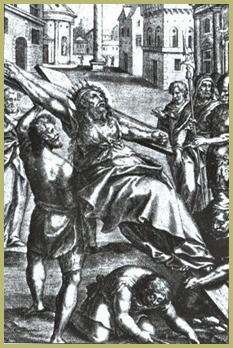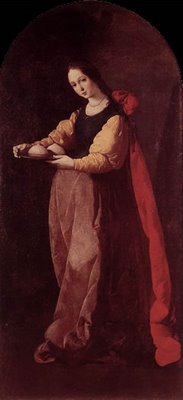
Martyrdom: around 330 AD
Patronage: Sailors
Saint Erasmus, also known as Saint Elmo, might have been a hermit on Mount Lebanon, or a bishop in Formia.
According to the legend, he was called before the judges during the persecuting under the Emperor Diocletian, and found guilty of being a Christian. He was beaten and spat upon, then beaten again with lead mauls until the veins in his body broke and burst. Erasmus was then thrown into a pit of snakes, and boiling oil and sulfur was poured on top of him; but "he lay therein as he had lain in cold water, thanking and loving God". According to the Golden Legend by Jacobus de Voragine. During his tortures, thunder and lightning struck, killing everyone around except the Saint. Diocletian then had him thrown into another pit, but an angel came and slew all the snakes. He was subsequently released.
After the emperor Diocletian came the Emperor Maximus. Maximus is said to be "worse than Diocletian". Since Saint Erasmus had not learned from the past tortures and was still preaching and spreading the word of god, Maximus had him put into a pan boiling with rosin, pitch, brimstone lead, and oil and had it poured into his mouth. Saint Erasmus still did not stop. Maximus then had him fitted into a searing hot cloak of metal, to no effect. The emperor then took Saint Erasmus to the pagan temple and forced him to sacrifice to the roman gods there, but they crumbled to dust. This enraged Maximus, so he put Saint Erasmus into a barrel protruding with spikes and rolled him down a hill. Erasmus came out unharmed. According to the Golden Legend, the Saint was then subjected to the following tortures:
"His teeth were plucked out of his head with iron pincers. And after that they bound him to a pillar and carded his skin with iron cards, and then they roasted him upon a gridiron...And did smite sharp nails of iron in his fingers, and after, they put out his eyes of his head with their fingers, and after that they laid this holy bishop upon the ground naked and stretched him with strong whites bound to horses about his blessed neck, arms, and legs, so that all his veins and sinews that he had in his body burst."
It is not clear how Erasmus escaped these tortures, but he ended up on Mount Lebanon as a hermit, and was fed by ravens. He was recaptured, beaten and whipped again, then coated in pitch and set alight. Finally, after Maximus threw him into prison with the intent of starving him to death, Erasmus managed to escape again.
He was recaptured,in the Roman province of Illyrcium, where he was martyred by having his stomach slit open and his entrails wound around a windlass (depicted above by Nicolas Poussin 1628). The use of this tool is how sailors took him as their patron saint.














